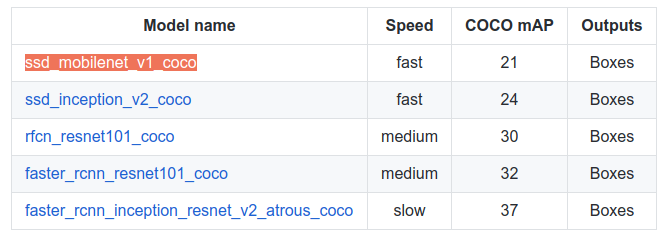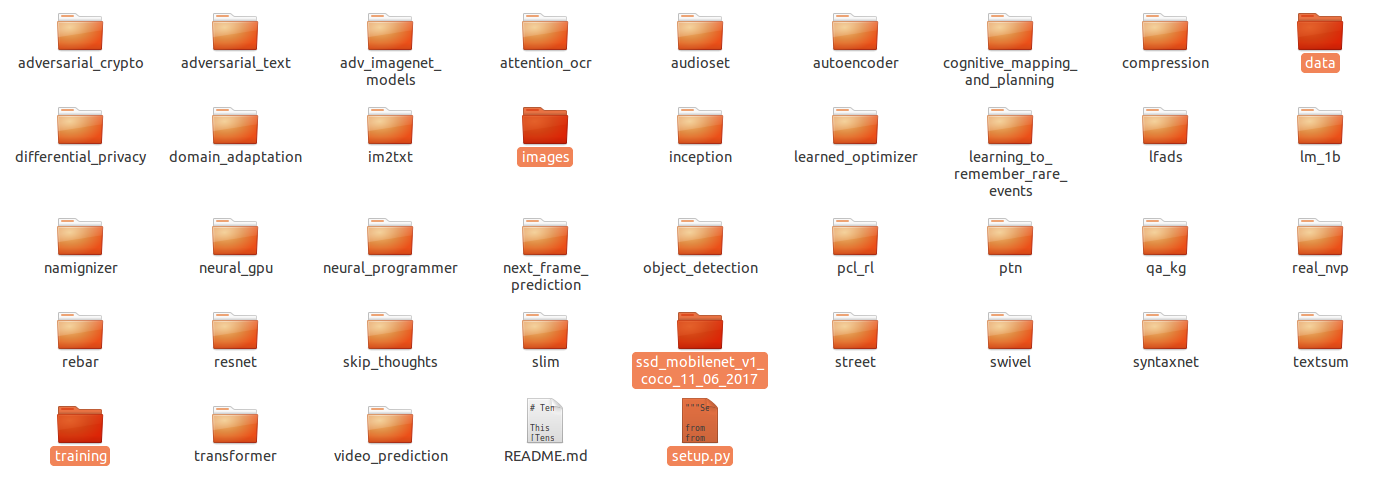[Tensorflow] Object Detection API - build your training environment
一、前期准备
Prepare protoc
Download Protocol Buffers

Create folder: protoc and unzip it.
unsw@unsw-UX303UB$ ls
models Others protoc train_data unsw@unsw-UX303UB$ ls protoc/
bin include readme.txt unsw@unsw-UX303UB$ ls protoc/bin/
protoc
Prepare model
Download model folder from tensorflow github.
unsw@unsw-UX303UB$ git clone https://github.com/tensorflow/models.git
Cloning into 'models'...
remote: Counting objects: 7518, done.
remote: Compressing objects: 100% (5/5), done.
remote: Total 7518 (delta 0), reused 1 (delta 0), pack-reused 7513
Receiving objects: 100% (7518/7518), 157.87 MiB | 1.17 MiB/s, done.
Resolving deltas: 100% (4053/4053), done.
Checking connectivity... done. unsw@unsw-UX303UB$ ls
annotations images models Others raccoon_labels.csv xml_to_csv.py unsw@unsw-UX303UB$ ls models/
AUTHORS CONTRIBUTING.md LICENSE README.md tutorials
CODEOWNERS ISSUE_TEMPLATE.md official research WORKSPACE
Enter: models/research/
# Set python env.
$ export PYTHONPATH=/home/unsw/Dropbox/Programmer/1-python/Tensorflow/ssd_proj/models/research/slim::pwd:pwd/slim:$PYTHONPATH
$ python object_detection/builders/model_builder_test.py
.......
----------------------------------------------------------------------
Ran 7 tests in 0.022s OK
Prepare train.record
Download: https://github.com/datitran/raccoon_dataset/blob/master/generate_tfrecord.py
"""
Usage:
# From tensorflow/models/
# Create train data:
python generate_tfrecord.py --csv_input=data/train_labels.csv --output_path=train.record # Create test data:
python generate_tfrecord.py --csv_input=data/test_labels.csv --output_path=test.record
"""
from __future__ import division
from __future__ import print_function
from __future__ import absolute_import import os
import io
import pandas as pd
import tensorflow as tf from PIL import Image
from object_detection.utils import dataset_util
from collections import namedtuple, OrderedDict flags = tf.app.flags
flags.DEFINE_string('csv_input', '', 'Path to the CSV input')
flags.DEFINE_string('output_path', '', 'Path to output TFRecord')
FLAGS = flags.FLAGS # TO-DO replace this with label map
def class_text_to_int(row_label):
if row_label == 'raccoon':
return 1
else:
None def split(df, group):
data = namedtuple('data', ['filename', 'object'])
gb = df.groupby(group)
return [data(filename, gb.get_group(x)) for filename, x in zip(gb.groups.keys(), gb.groups)] def create_tf_example(group, path):
with tf.gfile.GFile(os.path.join(path, '{}'.format(group.filename)), 'rb') as fid:
encoded_jpg = fid.read()
encoded_jpg_io = io.BytesIO(encoded_jpg)
image = Image.open(encoded_jpg_io)
width, height = image.size filename = group.filename.encode('utf8')
image_format = b'jpg'
xmins = []
xmaxs = []
ymins = []
ymaxs = []
classes_text = []
classes = [] for index, row in group.object.iterrows():
xmins.append(row['xmin'] / width)
xmaxs.append(row['xmax'] / width)
ymins.append(row['ymin'] / height)
ymaxs.append(row['ymax'] / height)
classes_text.append(row['class'].encode('utf8'))
classes.append(class_text_to_int(row['class'])) tf_example = tf.train.Example(features=tf.train.Features(feature={
'image/height': dataset_util.int64_feature(height),
'image/width': dataset_util.int64_feature(width),
'image/filename': dataset_util.bytes_feature(filename),
'image/source_id': dataset_util.bytes_feature(filename),
'image/encoded': dataset_util.bytes_feature(encoded_jpg),
'image/format': dataset_util.bytes_feature(image_format),
'image/object/bbox/xmin': dataset_util.float_list_feature(xmins),
'image/object/bbox/xmax': dataset_util.float_list_feature(xmaxs),
'image/object/bbox/ymin': dataset_util.float_list_feature(ymins),
'image/object/bbox/ymax': dataset_util.float_list_feature(ymaxs),
'image/object/class/text': dataset_util.bytes_list_feature(classes_text),
'image/object/class/label': dataset_util.int64_list_feature(classes),
}))
return tf_example def main(_):
writer = tf.python_io.TFRecordWriter(FLAGS.output_path)
path = os.path.join(os.getcwd(), 'images')
examples = pd.read_csv(FLAGS.csv_input)
grouped = split(examples, 'filename')
for group in grouped:
tf_example = create_tf_example(group, path)
writer.write(tf_example.SerializeToString()) writer.close()
output_path = os.path.join(os.getcwd(), FLAGS.output_path)
print('Successfully created the TFRecords: {}'.format(output_path)) if __name__ == '__main__':
tf.app.run()
generate_tfrecord.py
NB: we will do everything in models/research/ where the env has been set well.
So, move data/images here for generate_tfrecord.py
unsw@unsw-UX303UB$ pwd
/home/unsw/Dropbox/Programmer/1-python/Tensorflow/ssd_proj/models/research unsw@unsw-UX303UB$ python ../../generate_tfrecord.py --csv_input=../../data/raccoon_labels.csv --output_path=../../data/train.record
Successfully created the TFRecords: /home/unsw/Programmer/1-python/Tensorflow/ssd_proj/models/research/../../data/train.record
Now, we have got train_labels.csv (name changed from raccoon_labels.csv) train.record.
tfrecord数据文件是一种将图像数据和标签统一存储的二进制文件,能更好的利用内存,在tensorflow中快速的复制,移动,读取,存储等。
Prepare pre-train model
Download pre-trained model: https://github.com/tensorflow/models/blob/master/research/object_detection/g3doc/detection_model_zoo.md

Download configure file for pre-trained model: https://github.com/tensorflow/models/tree/master/research/object_detection/samples/configs

This configure is already in our model folder:
unsw@unsw-UX303UB$ pwd
/home/unsw/Programmer/1-python/Tensorflow/ssd_proj/models/research/object_detection/samples/configs
unsw@unsw-UX303UB$ ls
faster_rcnn_inception_resnet_v2_atrous_coco.config faster_rcnn_resnet101_voc07.config faster_rcnn_resnet50_pets.config ssd_inception_v2_pets.config
faster_rcnn_inception_resnet_v2_atrous_pets.config faster_rcnn_resnet152_coco.config rfcn_resnet101_coco.config ssd_mobilenet_v1_coco.config
faster_rcnn_resnet101_coco.config faster_rcnn_resnet152_pets.config rfcn_resnet101_pets.config ssd_mobilenet_v1_pets.config
faster_rcnn_resnet101_pets.config faster_rcnn_resnet50_coco.config ssd_inception_v2_coco.config
Configure based on your own data.
1 # SSD with Mobilenet v1, configured for Oxford-IIIT Pets Dataset.
2 # Users should configure the fine_tune_checkpoint field in the train config as
3 # well as the label_map_path and input_path fields in the train_input_reader and
4 # eval_input_reader. Search for "PATH_TO_BE_CONFIGURED" to find the fields that
5 # should be configured.
6
7 model {
8 ssd {
9 num_classes: 1
158 fine_tune_checkpoint: "ssd_mobilenet_v1_coco_11_06_2017/model.ckpt"
159 from_detection_checkpoint: true
160 # Note: The below line limits the training process to 200K steps, which we
161 # empirically found to be sufficient enough to train the pets dataset. This
162 # effectively bypasses the learning rate schedule (the learning rate will
163 # never decay). Remove the below line to train indefinitely.
164 num_steps: 200000
165 data_augmentation_options {
166 random_horizontal_flip {
167 }
168 }
169 data_augmentation_options {
170 ssd_random_crop {
171 }
172 }
173 }
174
175 train_input_reader: {
176 tf_record_input_reader {
177 input_path: "data/train.record"
178 }
179 label_map_path: "data/object-detection.pbtxt"
180 }
181
182 eval_config: {
183 num_examples: 2000
184 # Note: The below line limits the evaluation process to 10 evaluations.
185 # Remove the below line to evaluate indefinitely.
186 max_evals: 10
187 }
188
189 eval_input_reader: {
190 tf_record_input_reader {
191 input_path: "data/test.record"
192 }
193 label_map_path: "data/object-detection.pbtxt"
194 shuffle: false
195 num_readers: 1
196 }
As above, we need to create object-detection.pbtxt as following:
item {
id: 1
name: 'raccoon'
}
二、开始训练
Prepare training
Move all configure files based on ssd_mobilenet_v1_pets.config as following:
training folder: object-detection.pbtxt and ssd_mobilenet_v1_pets.config.

data folder: train.record and train_labels.csv.

Training on the way
Start training.
python object_detection/train.py --logtostderr --train_dir=training/ --pipeline_config_path=training/ssd_mobilenet_v1_pets.config INFO:tensorflow:Starting Session.
INFO:tensorflow:Saving checkpoint to path training/model.ckpt
INFO:tensorflow:Starting Queues.
INFO:tensorflow:global_step/sec: 0
INFO:tensorflow:Recording summary at step 0.
INFO:tensorflow:global step 1: loss = 14.5804 (33.780 sec/step)
INFO:tensorflow:global step 2: loss = 12.6232 (19.210 sec/step)
INFO:tensorflow:global step 3: loss = 12.0996 (17.102 sec/step)
Obviously, without GPU, life will be hard. GPU as following:
INFO:tensorflow:global step : loss = 15.2152 (9.041 sec/step)
INFO:tensorflow:global step : loss = 12.7308 (0.483 sec/step)
INFO:tensorflow:global step : loss = 11.9776 (0.450 sec/step)
INFO:tensorflow:global step : loss = 11.4102 (0.402 sec/step)
INFO:tensorflow:global step : loss = 10.8128 (0.427 sec/step)
INFO:tensorflow:global step : loss = 10.1892 (0.405 sec/step)
INFO:tensorflow:global step : loss = 9.2219 (0.396 sec/step)
INFO:tensorflow:global step : loss = 9.1491 (0.421 sec/step)
INFO:tensorflow:global step : loss = 8.5584 (0.400 sec/step)
[Tensorflow] Object Detection API - build your training environment的更多相关文章
- [Tensorflow] Object Detection API - prepare your training data
From: TensorFlow Object Detection API This chapter help you to train your own model to identify obje ...
- Install Tensorflow object detection API in Anaconda (Windows)
This blog is to explain how to install Tensorflow object detection API in Anaconda in Windows 10 as ...
- Tensorflow object detection API 搭建物体识别模型(三)
三.模型训练 1)错误一: 在桌面的目标检测文件夹中打开cmd,即在路径中输入cmd后按Enter键运行.在cmd中运行命令: python /your_path/models-master/rese ...
- 使用TensorFlow Object Detection API+Google ML Engine训练自己的手掌识别器
上次使用Google ML Engine跑了一下TensorFlow Object Detection API中的Quick Start(http://www.cnblogs.com/take-fet ...
- Tensorflow object detection API 搭建属于自己的物体识别模型
一.下载Tensorflow object detection API工程源码 网址:https://github.com/tensorflow/models,可通过Git下载,打开Git Bash, ...
- Tensorflow object detection API 搭建物体识别模型(四)
四.模型测试 1)下载文件 在已经阅读并且实践过前3篇文章的情况下,读者会有一些文件夹.因为每个读者的实际操作不同,则文件夹中的内容不同.为了保持本篇文章的独立性,制作了可以独立运行的文件夹目标检测. ...
- Tensorflow object detection API 搭建物体识别模型(二)
二.数据准备 1)下载图片 图片来源于ImageNet中的鲤鱼分类,下载地址:https://pan.baidu.com/s/1Ry0ywIXVInGxeHi3uu608g 提取码: wib3 在桌面 ...
- [Tensorflow] Object Detection API - predict through your exclusive model
开始预测 一.训练结果 From: Testing Custom Object Detector - TensorFlow Object Detection API Tutorial p.6 训练结果 ...
- TensorFlow object detection API应用
前一篇讲述了TensorFlow object detection API的安装与配置,现在我们尝试用这个API搭建自己的目标检测模型. 一.准备数据集 本篇旨在人脸识别,在百度图片上下载了120张张 ...
随机推荐
- history.pushState无刷新改变url
通过history.pushState无刷新改变url 背景 在浏览器中改变地址栏url,将会触发页面资源的重新加载,这使得我们可以在不同的页面间进行跳转,得以浏览不同的内容.但随着单页应用的增多,越 ...
- 继承之super关键字的使用
一.super关键字: 在对象的内部使用,可代表父类对象. 1. 访问父类的属性:super.age 2. 访问父类的方法:super.eat() 例: package 关键字extends; pub ...
- markdown 语法和工具
一 简明语法 来自: http://maxiang.info/ 二 markdown 语法: https://github.com/rhiokim/haroopad/blob/develop/Syn ...
- idea jsp html 空白页的问题
摘要 最近没事儿瞎折腾java web,在idea中,突然发现无法显示页面了. 问题 为什么会出现这个问题? 接触了过滤器的内容,然后在项目中添加了这样的一个过滤器,用来对post过来的数据进行ut8 ...
- 【springboot】【socket】spring boot整合socket,实现服务器端两种消息推送
参考地址:https://www.cnblogs.com/hhhshct/p/8849449.html
- Markdown 语法手册 - 完整版(下)
6. 引用 语法说明: 引用需要在被引用的文本前加上>符号. 代码: > 这是一个有两段文字的引用, > 无意义的占行文字1. > 无意义的占行文字2. > > 无 ...
- Android架构初探
#一 背景点评美团合并之后,业务需要整合,我们部门的几条业务需要往美团平台迁移,为了降低迁移成本,开发和维护成本,以及将来可能要做的单元测试,需要对架构进行相应的调整.之前的代码都堆在Activity ...
- 【NIO】Java NIO之缓冲
一.前言 在笔者打算学习Netty框架时,发现很有必要先学习NIO,因此便有了本博文,首先介绍的是NIO中的缓冲. 二.缓冲 2.1 层次结构图 除了布尔类型外,其他基本类型都有相对应的缓冲区类,其继 ...
- Vue中CSS模块化最佳实践
Vue风格指南中介绍了单文件组件中的Style是必须要有作用域的,否则组件之间可能相互影响,造成难以调试. 在Vue Loader Scope CSS和Vue Loader CSS Modules两节 ...
- Struct(二)
struct2 权威指南 这一节通过一个详细的实例来讲解Struct2框架的应用 1 下载和安装Struts 2框架 (1) 登录http://struts.apache.org/download.c ...
